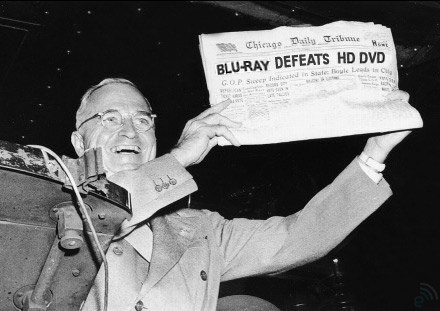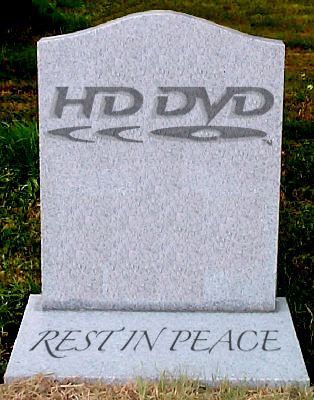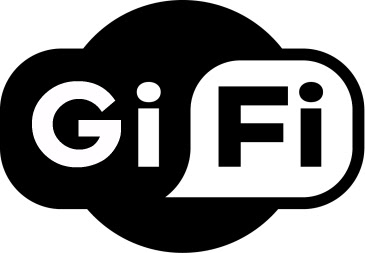 The last format war is over. HD DVD has been defeated by Blu-Ray. Everyone had seen this coming, except from Toshiba…
The last format war is over. HD DVD has been defeated by Blu-Ray. Everyone had seen this coming, except from Toshiba… Why HD DVD died?
Why HD DVD died?There are several reasons to explain HD DVD’s demise… but it actually narrows down to two things - the movie majors & the PS3.
 Technically, Blu-Ray is superior to HD DVD. It’s twice more in size - 25/50GB compared to 15/30GB. & it has a faster data transfer rate. But HD DVD is more user-friendly since it’s region-free & is much much cheaper than Blu-Ray. & it has Microsoft’s HDi interface…
Technically, Blu-Ray is superior to HD DVD. It’s twice more in size - 25/50GB compared to 15/30GB. & it has a faster data transfer rate. But HD DVD is more user-friendly since it’s region-free & is much much cheaper than Blu-Ray. & it has Microsoft’s HDi interface…In terms of add-ons, Blu-Ray favours users with more movie bonuses since it has more space to store them, while HD DVD rules with its user interactivity system (Microsoft HDi).
 For once, it wasn’t the consumers who decided which HD optical disc won the format war. After losing the VHS v/s Betamax war, Sony couldn’t afford another defeat & it decided to bet everything on Blu-Ray - by making Blu-Ray standard on all PS3s - a highly risky bet. Albeit PS3s are not that cheap, but they contributed significantly to Blu-Ray players overall sales. Toshiba on the other hand, was betting on the early-release of its HD DVD players.
For once, it wasn’t the consumers who decided which HD optical disc won the format war. After losing the VHS v/s Betamax war, Sony couldn’t afford another defeat & it decided to bet everything on Blu-Ray - by making Blu-Ray standard on all PS3s - a highly risky bet. Albeit PS3s are not that cheap, but they contributed significantly to Blu-Ray players overall sales. Toshiba on the other hand, was betting on the early-release of its HD DVD players. After almost a year of stalemate, whereby Blu-Ray kept its steady ascent in sales while HD DVD players kept getting cheaper… a major breakthrough came through the movie studios’ decision to stop dual-format sales. Sony managed to entice Warner into the Blu-Ray camp for an undisclosed sum (reports put it at $400 Million!). HD DVD meanwhile decided to radically slash prices, with some players being sold at $99. When Wal-Mart, Best Buy & other retailers followed Warner Studios, everyone knew it was over. & finally Toshiba declared HD DVD officially dead on the 15th of Feb.
After almost a year of stalemate, whereby Blu-Ray kept its steady ascent in sales while HD DVD players kept getting cheaper… a major breakthrough came through the movie studios’ decision to stop dual-format sales. Sony managed to entice Warner into the Blu-Ray camp for an undisclosed sum (reports put it at $400 Million!). HD DVD meanwhile decided to radically slash prices, with some players being sold at $99. When Wal-Mart, Best Buy & other retailers followed Warner Studios, everyone knew it was over. & finally Toshiba declared HD DVD officially dead on the 15th of Feb. The winners:
The winners:Sony - Sony has managed to keep itself from going bankrupt & can now bring in the royalties. & the PS3 is looking to cash on that!
Movie Studios - They can finally focus on a single format that offers better protection than HD DVD.
Consumers - The format war was ultimately a great thing. Prices had massively been cut down. But now after the war, Blu-Ray players will still be sold at the same price.
The losers:
Toshiba - Toshiba has lost everything. With HD DVD dead, it’d take quite some time for the company to recover.
Consumers - Everyone who bought HD DVD players must be cursing themselves. & it will take some time to crack Blu-Ray’s BD+ protection!
Check the whole story on Engadget…
& conspiracy theories that Sony bought off Toshiba...
[Wiki] Comparison of the two formats
[Wiki] The format war
What’s next?
 The format of the future is the Holographic Versatile Disc (HVD) which can hold up to 3.9TB (3900GB) of data! I know you must be thinking that who would need such a gigantic amount of storage, when the biggest hard disk you can buy is just 1TB! But technology changes faster that you can say “huh?” - just like this 40Gbit/s connection in Sweden.
The format of the future is the Holographic Versatile Disc (HVD) which can hold up to 3.9TB (3900GB) of data! I know you must be thinking that who would need such a gigantic amount of storage, when the biggest hard disk you can buy is just 1TB! But technology changes faster that you can say “huh?” - just like this 40Gbit/s connection in Sweden. HVD belongs to the next generation of storage media - 3D optical data storage. DVDs are considered 2D while HVD uses holograms. Holograms use several layers of images to make an image appear 3D - just like those shiny “genuine” holograms that display different images at different angles (More on holograms here). In the same way, on a multi-layered disc, we can burn 3D data by using two different lasers made to reflect at different angles.
HVD belongs to the next generation of storage media - 3D optical data storage. DVDs are considered 2D while HVD uses holograms. Holograms use several layers of images to make an image appear 3D - just like those shiny “genuine” holograms that display different images at different angles (More on holograms here). In the same way, on a multi-layered disc, we can burn 3D data by using two different lasers made to reflect at different angles.Read with Wiki for the technical details.
http://en.wikipedia.org/wiki/Holographic_Versatile_Disc
http://en.wikipedia.org/wiki/Holographic_data_storage
http://en.wikipedia.org/wiki/3D_optical_data_storage
HVD uses two different lasers - red & green. While red is the most used laser in the world, & blue is just round the corner, there’s a huge lack of green lasers. So actually, it will require some time for the green lasers to be commercially viable before we see a public version of the HVD. But with the dawn of laser TVs & handheld micro-projectors, cheap production of green lasers has been on fast track. So finally, the next 3D optical format war may take place within the next 5 years…
Or the next format war may NOT take place!
 Again using the example of the 40Gbit/s connection in Sweden (the world’s fastest - 5GB/s), that has been put into the hands of a 75-year old woman! The connection uses a normal fibre optic cable with a new modulation technique which allows data to be transferred directly between two routers up to 2,000 kilometres apart, with no intermediary transponders.
Again using the example of the 40Gbit/s connection in Sweden (the world’s fastest - 5GB/s), that has been put into the hands of a 75-year old woman! The connection uses a normal fibre optic cable with a new modulation technique which allows data to be transferred directly between two routers up to 2,000 kilometres apart, with no intermediary transponders. Another example is GiFi. Researchers at the Melbourne University have managed to achieve speeds of up to 5Gbps (0.63GB/s) on a new wireless chip. The device has a short-range like Bluetooth, but uses only a 5mm square chip & a 1mm antenna that uses less than 2 watts of power! GiFi operates on the unused 60GHz frequency & is expected to have a cost-per-chip of $10. Watch out for the future demise of Bluetooth.
Another example is GiFi. Researchers at the Melbourne University have managed to achieve speeds of up to 5Gbps (0.63GB/s) on a new wireless chip. The device has a short-range like Bluetooth, but uses only a 5mm square chip & a 1mm antenna that uses less than 2 watts of power! GiFi operates on the unused 60GHz frequency & is expected to have a cost-per-chip of $10. Watch out for the future demise of Bluetooth.[via TheAge.com.au]
 & finally... Japan has launched the Kizuna satellite that promises Internet speeds up to 1.2Gbps for Japanese islands… Not a total of 1.2Gbps… but a 1.2Gbps connection for each user. & unlike fibre optics, it is not affected by natural disaster - only a receiving antenna is needed.
& finally... Japan has launched the Kizuna satellite that promises Internet speeds up to 1.2Gbps for Japanese islands… Not a total of 1.2Gbps… but a 1.2Gbps connection for each user. & unlike fibre optics, it is not affected by natural disaster - only a receiving antenna is needed.[via Gizmodo]
 All of the above point to a single thing - the future of content distribution doesn’t lie in traditional media like DVDs, Blu-Rays but on the Internet. Tomorrow, we will not be buying HD discs, but rather downloading them off the Web with our ultra-fast internet connections. With a 40Gbit/s connection, you can download a DVD in 2s... but only if we can afford such a connection… an utopia for most people!
All of the above point to a single thing - the future of content distribution doesn’t lie in traditional media like DVDs, Blu-Rays but on the Internet. Tomorrow, we will not be buying HD discs, but rather downloading them off the Web with our ultra-fast internet connections. With a 40Gbit/s connection, you can download a DVD in 2s... but only if we can afford such a connection… an utopia for most people!
Please don't spam & don't swear!
Subscribe to my feed
very cool
must have 40gbit connectionn now! In my town we only get 6mbps and .75mbps up!
Post a Comment
Some html tags like <b>, <i>, <a> are allowed & emos can be used. ;)
Copy your comment before posting in case something fails.
Comments are moderated, may take a while to appear.